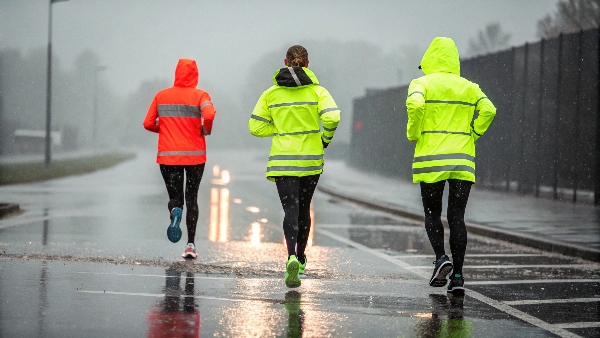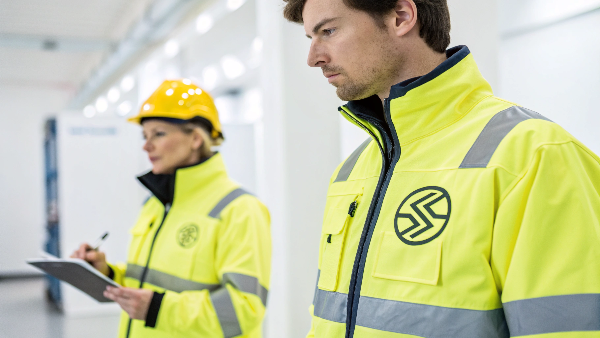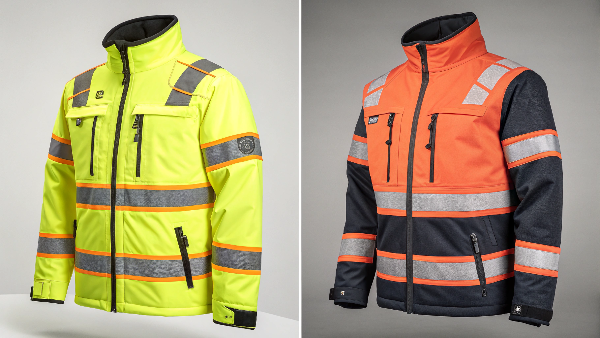Let’s say you’re running a construction site at night. You have heavy equipment moving around, and your crew is bustling about. It’s dark, and people are getting hurt. You’re standing there, and you see a guy step in front of a piece of equipment. The only reason you see him is because the headlights hit the reflective tape on his vest. The driver stops, and the guy doesn’t get run over. Reflective tape saves lives. But how does it work? What are the benefits?
How Does Sew-On Reflective Tape Work?
How It Works
Sew-on reflective tape operates on a simple yet effective principle: retroreflection. This involves the tape containing thousands of tiny glass beads or prisms, approximately 50,000 per square inch, that collect, focus, and reflect light back to its source.
- Collection and Focusing: The thousands of tiny glass beads embedded in the tape collect incoming light and focus it.
- Reflection: Once focused, the light is bounced back in the direction it came from.
- Retroreflection: This process of reflecting light directly back to its source is called retroreflection. When a light source like car headlights hits the tape, it appears extremely bright to the observer at the light source.
- Directional Reflection: The tape only lights up for the person with the light source or in line with it. Someone viewing from a different angle may not see the reflection.
- Angle Flexibility: The tape can reflect light back even when it's not perfectly flat or perpendicular to the light source, though flat-on provides the best reflection.
- Multiple Beam Reflection: The tape can reflect multiple beams back in various directions simultaneously.
This retroreflective property makes the tape appear extremely bright when illuminated at night, significantly enhancing the wearer’s visibility.
Benefits
Increased Visibility and Safety
- Enhanced Nighttime Visibility: Sew-on reflective tape makes the wearer much more visible to drivers and others at night or in low-light conditions. It can help prevent accidents by increasing visibility up to 200 meters away.
- Accident Prevention: Reflective tape reduces crashes involving vehicles by up to 41%, especially for nighttime rear and side impacts.
Versatility
- Wide Range of Applications: The tape can be easily sewn onto clothing, bags, hats, gloves, and other items. It is available in various colors, sizes, and styles to suit different needs.
- Customizable: It can be cut to desired sizes and shapes and is available in different materials like fabric or vinyl to suit various applications.
Durability
- Washable and Wear-Resistant: Sew-on reflective tape is washable and can withstand repeated washing and wear. Some types are flame-resistant for added safety.
- Weather and UV Resistance: The tape is designed to withstand harsh environmental conditions, including exposure to sunlight and weather.
Flexibility
- Conformable: Fabric versions of the tape can be folded and bent to conform to garment shapes, making them suitable for a variety of applications.
Cost-Effective Safety Solution
- Affordable: Sew-on reflective tape is a relatively inexpensive way to significantly enhance nighttime visibility. For less than $30, most single-unit trucks can be equipped with reflective tape.
By incorporating sew-on reflective tape into clothing and gear, people can greatly improve their visibility and safety during nighttime activities like running, cycling, or working in low-light conditions. The tape's ability to brightly reflect light makes it an effective and versatile safety feature for many applications.
Transition Paragraph
Now that we’ve covered the basic workings and immediate benefits of sew-on reflective tape, let's dive deeper into its broader applications and advantages. Understanding these can help you make informed decisions about the best ways to incorporate reflective tape into your safety protocols.
What Are the Benefits of Reflective Tape?
Reflective tape offers several key benefits for safety and visibility:
Increased Visibility
- Enhanced Low-Light Visibility: Reflective tape makes objects, vehicles, and people much more visible in low-light conditions or at night. It reflects light back to its source, making it highly visible to drivers and others.
- Long-Distance Visibility: Reflective tape can help prevent accidents by increasing visibility up to 200 meters away.
Accident Prevention
- Reduction in Crashes: Reflective tape reduces crashes involving vehicles by up to 41%, especially for nighttime rear and side impacts.
- Fatality and Injury Prevention: It is estimated to prevent 191-350 fatalities and up to 5,000 injuries annually.
Cost-Effective Safety Solution
- Affordable Safety Measure: Reflective tape is a relatively inexpensive way to significantly enhance nighttime visibility. For less than $30, most single-unit trucks can be equipped with reflective tape.
Versatility
- Wide Range of Applications: Reflective tape can be applied to vehicles, bicycles, clothing, equipment, stairs, loading docks, and more. It is available in various colors and styles for different applications.
Durability
- Weather and UV Resistance: Reflective tape is weather-resistant and UV-resistant. Some types carry warranties of up to 10 years.
- Long-Lasting: Reflective tape remains effective through multiple washes and various weather conditions.
Legal Compliance
- Regulatory Compliance: Reflective tape helps businesses comply with safety regulations for vehicles and workplaces.
Brand Awareness
- Customizable: Reflective tape can be customized with company logos to build brand visibility while improving safety.
Liability Reduction
- Safety Commitment: Demonstrating a commitment to safety by using reflective tape can potentially reduce liability in accident claims.
By improving visibility and safety in various environments, reflective tape helps prevent accidents, protect assets, and potentially save lives.
How Does Reflective Tape Work?
Reflective tape works through a process called retroreflection. Here's how it functions:
Tiny Glass Beads or Prisms
- Glass Beads: The tape contains thousands of tiny glass beads (about 50,000 per square inch) or prisms.
- Prisms: Some reflective tapes use prismatic technology for enhanced reflection.
Light Collection and Focusing
- Collection: These glass beads or prisms collect incoming light.
- Focusing: The collected light is then focused by the beads or prisms.
Light Reflection
- Reflection: The focused light is bounced back in the direction it came from.
- Retroreflection: This process of reflecting light directly back to its source is called retroreflection.
Visibility Enhancement
- Bright Reflection: When light from a source like car headlights hits the tape, it appears extremely bright to the observer at the light source.
Directional Reflection
- Focused Reflection: The tape only lights up for the person with the light source or in line with it. Someone viewing from a different angle may not see the reflection.
Angle Flexibility
- Flexible Reflection: The tape can reflect light back even when it's not perfectly flat or perpendicular to the light source, though flat-on provides the best reflection.
- Multiple Beam Reflection: The tape can reflect multiple beams back in various directions simultaneously.
This retroreflective property makes objects with reflective tape highly visible in low-light conditions, significantly enhancing safety for various applications like road signs, vehicles, clothing, and safety equipment.
How Long Does Reflective Tape Last?
Reflective tape has varying lifespans depending on the type and quality of the tape. Here's a breakdown of how long different types of reflective tape typically last:
General Range
- Typical Lifespan: Most reflective tapes last between 3 to 10 years.
Specific Types
- Reflective Sheeting: 1-3 years
- Honeycomb Reflective Tape: 1-3 years
- High-Intensity Reflective Tape: 5-7 years
- Micro-Prismatic Reflective Tape: 5-10 years
Engineering Grade Reflective Tape
- High-Quality Tapes: Some high-quality engineering grade tapes can last up to 7 years.
Factors Affecting Lifespan
- Type and Thickness: The type and thickness of the tape used can affect its lifespan.
- Environmental Conditions: Exposure to sunlight, weather, and other environmental factors can impact the tape's durability.
- Surface Application and Maintenance: Proper application and maintenance can extend the tape's lifespan.
Material Composition
- PET and PVC Tapes: Generally have shorter lifespans.
- PC and Acrylic-Based Tapes: Tend to last longer.
Outdoor Use
- Outdoor Rated Tapes: Some reflective tapes are rated for outdoor use with a 7-year lifespan.
It's important to note that while the tape may physically last for several years, its reflective properties may diminish over time. Regular inspection and replacement when needed are recommended to ensure optimal visibility and safety.
Which Reflective Tape Is Best?
There is no single "best" reflective tape for all applications. The optimal choice depends on several factors:
Brightness
- Maximum Brightness: If maximum brightness is the top priority, the brightest option is Oralite AP1000 film, used in products like M82 SOLAS marine tape. It can reflect over 1000 candelas.
Application Needs
- Curved Surfaces: For curved surfaces, more flexible options like Oralite V98 Conformable Prismatic or Nikkalite Flexible Engineer Grade are better.
- Traffic Applications: For traffic applications requiring wide-angle visibility, Nikkalite High Intensity Type 3/4 or Oralite 7900 Brilliant Grade work well.
Distance
- Long-Distance Visibility: For long-distance visibility (1000+ feet), micro-prismatic tapes like Oralite V82 or SOLAS are best.
- Shorter Distances: For shorter distances (within 300 feet), engineer grade tapes are suitable.
Durability
- Long Lifespan: Some high-intensity and micro-prismatic tapes offer 5-10 year outdoor lifespans.
Cost
- Affordability: Engineer grade tapes are generally most affordable, while SOLAS and high-intensity options are more expensive.
Color Options
- Variety of Colors: Engineer grade offers the widest variety of colors.
Specific Certifications
- Certifications: Some tapes meet standards for marine use (SOLAS), vehicle conspicuity (DOT), or school bus markings.
The key is to consider your specific needs in terms of application, viewing distance, environmental conditions, and budget when selecting a reflective tape. For general-purpose use, Flexible Engineer Grade Type 1 is popular and versatile, while micro-prismatic tapes offer maximum brightness for critical safety applications.
Is Reflective Tape Effective?
Yes, reflective tape is highly effective for improving visibility and safety. Here are the key points about its effectiveness:
Accident Reduction
- Nighttime Accident Reduction: Reflective tape reduces nighttime accidents involving heavy trailers by 21-41%.
- Rear and Side Impact Reduction: Decreases rear and side impacts from vehicles by up to 29%.
- Fatality and Injury Prevention: Estimated to prevent 191-350 fatalities and up to 5,000 injuries annually.
Increased Visibility
- Long-Distance Visibility: Makes objects visible from up to 1000+ feet away with proper tape selection.
- Low-Light Visibility: Significantly improves visibility in low-light conditions.
Cost-Effective Safety Solution
- High ROI: For less than $30, most single-unit trucks can be equipped with reflective tape, providing a high return on investment in terms of accident prevention and liability reduction.
Long-Lasting Performance
- Durability: Many types last 5-10 years, with some offering warranties up to 10 years.
- Weather Resistance: Remains effective through multiple washes and various weather conditions.
Versatility
- Multiple Applications: Effective on vehicles, clothing, equipment, signs, and many other applications. Available in various colors and styles to suit different needs.
Scientifically Proven
- Proven Effectiveness: Multiple studies by organizations like the National Highway Traffic Safety Administration (NHTSA) have confirmed its effectiveness.
Regulatory Recognition
- Legal Requirements: Required by law on certain vehicles due to its proven safety benefits.
Overall, reflective tape is considered a highly effective, durable, and affordable safety measure that significantly enhances visibility and reduces accidents in low-light conditions.
Conclusion
In summary, sew-on reflective tape is a great way to keep people from
getting killed. It works in low-light conditions. It’s cheap. It’s durable. It’s
versatile. It’s easy to use. If you know how it works and what it does, you
can make a decision to use it to make your environment safer. Use it on
people. Use it on vehicles. Use it on equipment. Use it to keep people from
getting killed.



